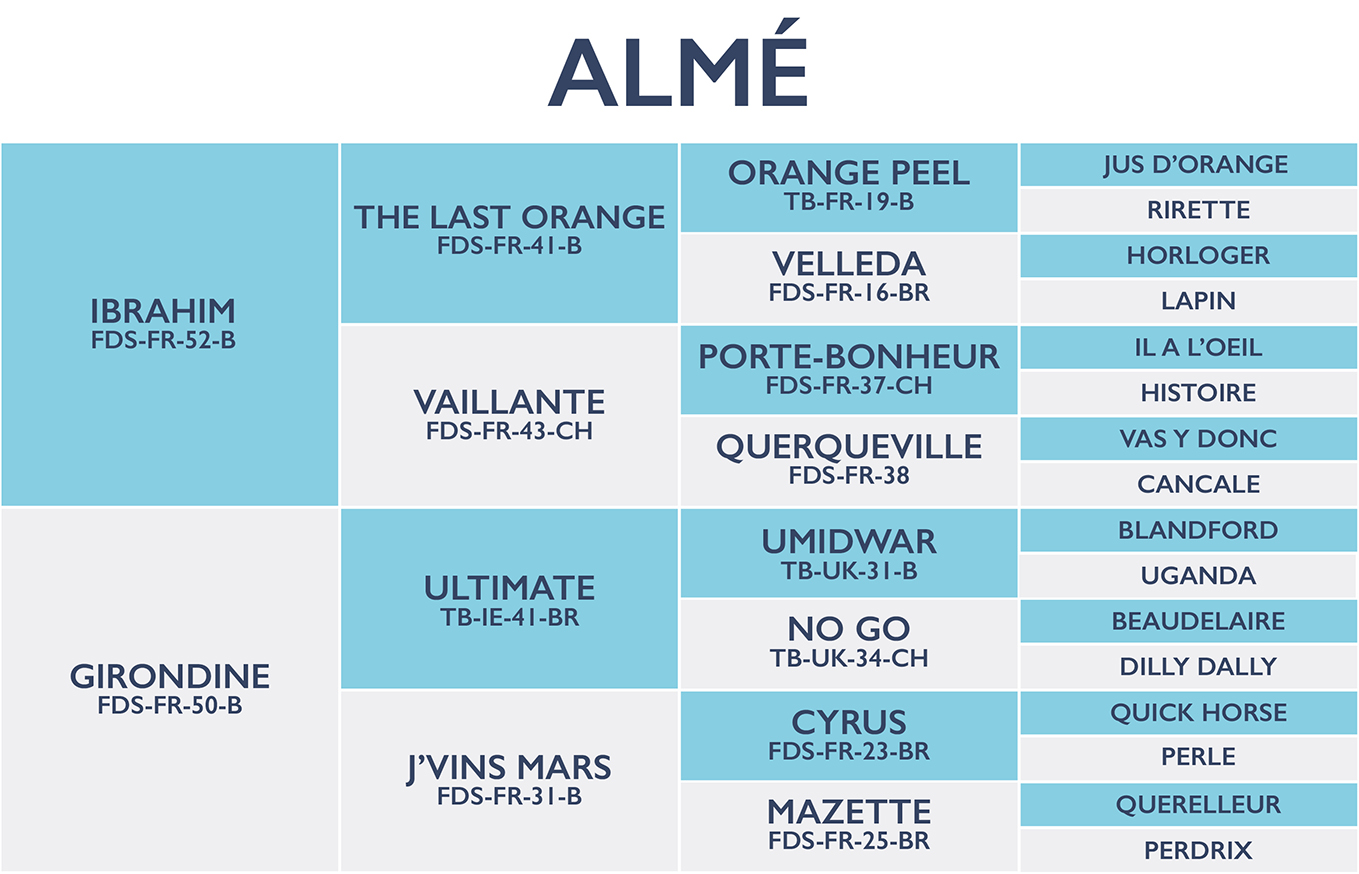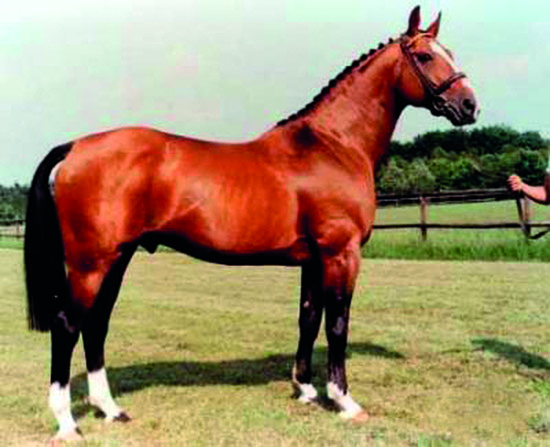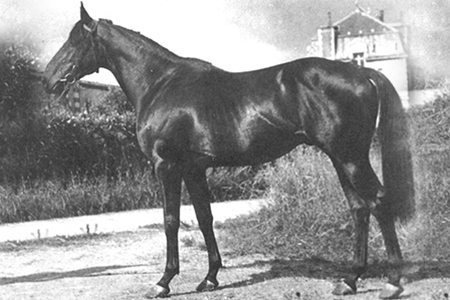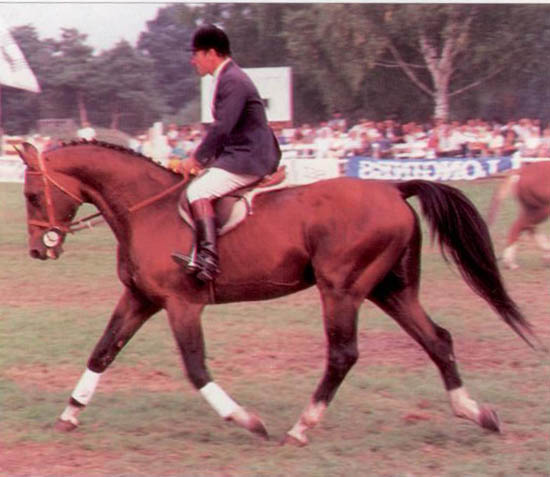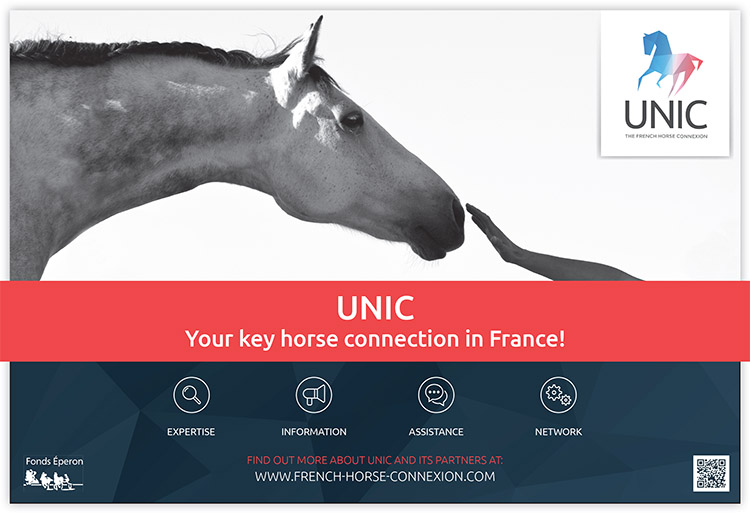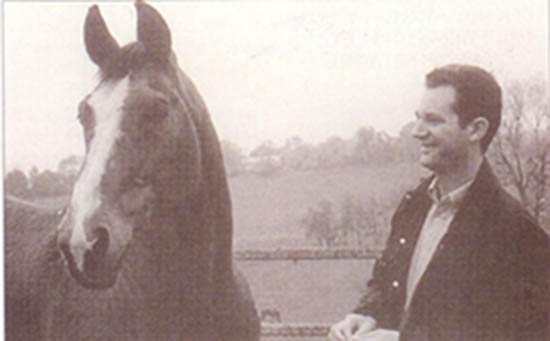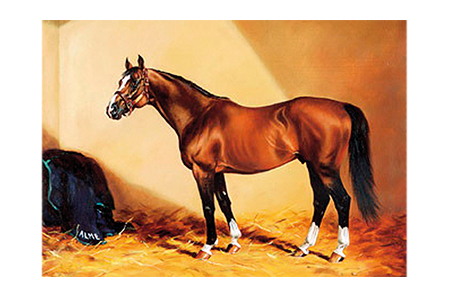1966 – 1991, 165 cm Bay
Served France 1971-74; Zangersheide 1975-85, France 1986-1991
Breeder – Alphonse Chauvin
Almé was by the great French stallion, Ibrahim out of Girondine.
Almé’s dam, Girondine was a daughter of the Irish bred Thoroughbred, Ultimate, and as well as Almé, she also produced his three full-brothers, all licensed stallions or successful jumpers. Her daughter, La Citadelle (by Jus de Pomme) was bred to Ibrahim to produce three top stallions: Espoir (sold to Spain), Gibramino (sold to Belgium) and Quastor who stood at St-Lô.
Ultimate xx
The American, Fred Graham purchased Almé at the age of three. He was put into training at Anaud Evain’s stud, Le Cour Bonnet, under the supervision of Captain Gruppelaar. Almé was sometimes ridden by his owner but most of the time by Michel Parot. Almé went on to compete internationally with François Mathy and Johan Heins.
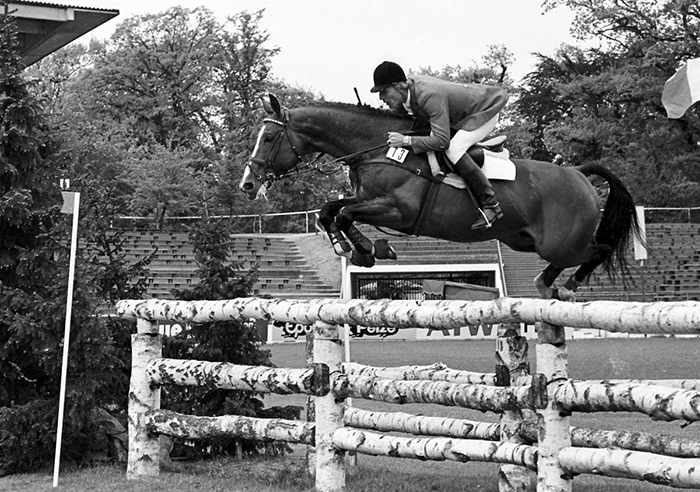
Almé’s last public appearance, at Fontainbleau in 1989
Before he left France for Belgium, he produced the stallion sons, Galoubet, I Love You, and Jalisco, all of whom competed internationally.
At the time Almé stood at Zangersheide, the horses bred there were being registered in the Hanoverian studbook, but this did not prevent the Almé genes making their way to Holstein where they were happy to use Ahorn Z (out of the Holstein mare, Heureka) and Aloubé Z and Athlet Z, both out of Hanoverian mares of Gotthard breeding.
In the south west of Germany, Alexis Z – who is out of the Hanoverian mare, Wonne, herself an international performer with Peter Schmitz – was enormously successful and he was soon used in both Holstein and Hanover.
There is one drawback to the Almé line – many of his sons and grandsons, like him, suffer from scrotal hernia, and some after colic have had a testicle removed. Still he is acknowledged as one of the all time great stallions of Europe.
In the 2003 edition of Annuaire Monneron, Bernard le Courtois, has this to say about the present influence of Almé, describing him as ‘father of world breeding’:
“It is obviously no surprise to see that the line of Ibrahim is influential in French breeding. Almé’s line is becoming increasingly important in many great breeding countries as could be seen during the World Championship in Jerez 2002. I have received from the USA an analysis of the results, which I find interesting and would like to share with you. Among the 92 horses participating, the division between the sexes is relatively well balanced: 32 uncastrated males, not all of them stallions, 34.8%, 31 geldings, 33.7% and 29 mares, 31.5%. Five stallions had more than one product: Quidam de Revel (5), Capitol I (4), Le Tot de Sémilly (3), Robin Z and Touchdown (2 each). Quidam, Robin and Touchdown are grandsons of Almé and 21 horses in the event (22.3%) were descendants of Almé. At the end of the speed class and of the Nations Cup we could count among the Top 25: 10 stallions, 7 geldings and 8 mares; 9 of them came from Almé (36%). When we arrive at the Top 10 (after two rounds of the individual championships) we find ourselves with four stallions, one gelding and four mares, four of them from Almé (40%). The four horses in the final (where the riders swapped horses) comprised one stallion and three mares, three of them from Almé, 75%! If we were to draw some preliminary, hasty, but nonetheless interesting conclusions we might suggest that if we want to produce horses of high quality the best way would be to invest in mares coming from our leader of the dynasty, Almé. One thing is sure and certain, and that is that Almé remains a valuable asset in the pedigrees of our sport horses. And everything comes together when we remember that the best six year old in Europe this year – Mozart des Hayettes – had Almé twice in his pedigree.”
It was Bernard le Courtois, who single handedly returned Almé from Zangersheide. On his website, www.brullemail.com, he has this wonderfully impassioned account of how he brought Almé back to France:
“The French breeders and riders became aware of the enormous loss represented by Almé’s exportation, but few breeders were prepared to go abroad to have their mares covered. However some made the effort in 1991 and thanks to them we have several five and six year olds in competition. In the meantime Almé had been operated on for an inguinal hernia and in 1984 became mon-orchid. The Dutch then sold him and he returned to Belgium.”
“But what, I hear you say, were the French doing? What were they waiting for to bring their stallion home? Particularly when they had several opportunities to do so.”
“An offer had been made by the UNIC on behalf of the National Stud Farms, I remember the offer being F350,000. A ridiculous sum (double the price of a 3 year old at the St Lô Stallion sale) for the best stallion in the World, even if he was 18 years old and mon-orchid.”
“At the time I was the Chief Editor of the magazine L’Eperon. I had heard of this offer and of Almé’s return to Zangershiede, and decided to go there myself to see this dream stallion at last, having been too young to have seen him in France.”
“So I went to Belgium, between Liege and Aix La Chapelle, and realised that despite his age and far from calm life, Almé was still an admirable horse. I also learnt that two offers had been made for him, not from France, but by Americans and Venezuelans. On one side there was an offer of big shiny dollars and on the other, thousands of acres of Pampas.”
“What could I, a modest stud farmer, a passionate but poor breeder, do faced with such superpowers? I knew no rich patron as fanatic about breeding as myself and no bank would have lent me enough money to repatriate Almé. But the idea became a target and then an obsession.”
“A few months beforehand, on my return from the Olympic Games at Los Angeles, I had managed to retrieve a 17 year old stallion I liked a lot, the Thoroughbred, Laudanum. He had been forgotten and sent to the south west of France and had only covered nine mares in all in 1984. To acquire him I had applied a principle common to the racing world, ie. sale to Shareholders.”
“Laudanum’s syndicate had succeeded and the following year he had covered 63 mares. Pleased with my success I decided to use the same principle to save our genetic heritage and bring back Almé to French Breeders. Negotiations were long and difficult. I often grew depressed about the attitude of the people I was dealing with, who did not keep their word and refused to sign any contract.”
“The 1985 breeding season was wasted for us, Almé stayed in Zangersheide.”
“The Americans were willing to pay a lot of money for Almé. It should be remembered that his son, Galoubet, had been bought by syndicate in the USA one year before, for the sum of $2,000,000. At a time when the dollar was worth 10 Francs, this represented 20 million Francs. They could afford to be stubborn. However Almé’s weaknesses were to my advantage. I won the first round of the fight. Almé could not go to the USA because he showed positive on a biabose test. Unwilling to give up completely the Americans decided to leave Almé in Belgium and import his frozen sperm. Second round won, Almé’s sperm could not be frozen!”
“The Americans gave up the fight leaving the Venezuelans and their acres of Pampas. Here dialogue won the day. To export a stallion like Almé to South America was nothing less than a burial. I was left with three points to argue with: French breeding, international commerce and the financial structure that was to repatriate Almé.”
“The person with whom I was negotiating accepted the principle but still would not sign the contract allowing Almé’s return. Negotiations had been going on for nine months. I was furious and about to abandon the idea when, whilst at the Fontainebleau European Championships in 1985, I issued a deadline. After several heated discussions I left Fontainebleau with my contract signed.”
Almé and his rescuer – Bernard le Courtois
“Almé was to return to France. His official comeback was to be a month later at the Dinard European Championship. My incredible gamble had been won, I announced in the magazine Almé’s amazing and unhoped for comeback.”
“Almé’s comeback must have disturbed quite a few people. I heard so much rubbish, either directly or repeated to me, from people who are meant to be authorities in the horse world and who I believed to be intelligent or at least reasonable.”
“According to them Almé was little more than a rocking horse, and sterile to boot! Obviously, as a tenderfoot, I was made out to be a fool, if not worse.”
“However Almé’s presentation put things in place and silenced more than a few. Almé, then 19 years old, was on dazzling form. I’ll always remember his presentation and the admiring gaze of hundreds of people passing the message, ‘It’s Almé’.”
“Accompanied by Handel’s magic Saraband, Almé made his comeback on the grounds at Dinard in front of thousands of spectators entranced by his beauty and the charisma of the horse whose reputation was at its peak.”
“I admit that the emotion brought tears to my eyes. A moment of great satisfaction and pleasure: pleasure in the beauty of the scene and the satisfaction in the work accomplished. False modesty aside I was also very proud.”
“The follow up was just as exciting. Shares in Almé were a great success. There were 70 – 80 shares for sale at F20,000 (today this seems cheap but in six years horse prices have greatly increased). Within a few days all the shares were sold and the money raised to buy Almé.”
“In the space of a few weeks I received almost 400 requests to buy shares. Real Almé fans contacted me unfortunately too late. Every day I had to return cheques arriving too late. Some were even signed blank accompanied by a note to say: ‘I’ve heard that Almé is for sale to a syndicate, I don’t know the conditions but please keep me one or two shares and fill in the enclosed cheque’.”
“Incredible, this enthusiasm and confidence were a great comfort to me. It was without doubt this owners association which made me decide to make the move to Normandy and set up as a stallion breeder.”
“During 1986 – 87 Almé’s fresh sperm was used for artificial insemination, 100 mares per season. Mares came from all over France as well as from Belgium, Holland, Great Britain, Switzerland and Italy. In 1988-89 I limited him to 80 mares and in 1990 to 60 because of his age and state of health. Out of the 420 mares covered during five years, with an average fertility rate of 78%, many products were exported and roughly 20% of the mares covered gave birth abroad (foreign mares or mares in foal exported) added to these are the dozens of Almé foals of all ages exported to Italy, Belgium and Sweden over the past five years…”
“It should also be noted that Almé foals are not precocious, needing to be patiently conserved and not shaken around at the age of four. Observe their elders, Galoubet, I Love You or Jalisco who were hardly out at the age of four. Only at five years old were they beginning to be noticed. The future will smile at those who are patient with their mounts. However despite the numerous exports and mares kept for breeding at three years (some of whom will appear the late five year olds next year) there were 12 Almé products in the 1991 Fontainebleau final.”
“Almé, once named by a journalist the “Golden Goose” was retired in August 1990.”
“It gave me the great satisfaction to see him finish his days with me at the Brullemail stud farm. From my office, where I sit to tell you this story, I used to see his head over his box door every day, so expressive despite his age. I could hear his high pitched neigh, so unusual, like a dolphin, as the mares crossed the courtyard or came in from pasture.”
“His deteriorating health over the last year had pushed me to put him into retirement. Despite an excellent appetite Almé grew thin, like an old man living slowly between the fireside and the window. He was saving himself and would enjoy his daily outing on the lawn while the lad cleaned his box.”
“Almé led a full life through breeding and sport. His glory crossed frontiers and his name is honoured in equestrian countries world-wide. The only horse with a comparable family tree and with whom he has often been compared is Northern Dancer. Almé’s legacy is already assured by the extraordinary quality of his sons, already working stallions, and will gain from the arrival on the sports field his five new generations.”
“Today Almé is the only stallion in the World to have fathered two World Champions and three Olympic horses. During the Eighties an Olympic team could have been made up of his sons alone. Only Furioso could have done that in the sixties. In 1991 Jalisco may hope to do as much, being a product of both Furioso and Almé.”
“1990, the year in which Almé retired was also the year in which Eric Navet won the title of World Champion with the young stallion Quito de Baussy, a grandson of Almé. His blood lives on.”
“Almé will always be the stallion of the century. I am always touched when I think or talk of him. For a breeder it is fabulous to encounter such a horse during a career. I thank my lucky stars for such joy and satisfaction.”
“But memories are not enough. The future has to be prepared; breeding is a long daily task. The new generation has to be prepared, new progenitors found and maybe one day I will meet the stallion of his calibre, his brilliance and strength who will go to make a phenomenon such as Almé.”
In the 2007-2008 edition of Monneron, Bernard le Courtois, after spending many hours on his computer, produced a list of the top 75 jumping stallions in the world, on the basis of the FEI list of the top 2515 jumping horses in international competition. This survey once again, confirms Almé’s pride of place, for he is responsible for 17 of the 57 leading stallions on the leaderboard. Four of these stallions are by Jalisco, the most important of which is Quidam de Revel, who heads the standings with 48 representatives. Quidam himself already has two of his sons on the leader board, Nabab de Reve and Guidam. Another Jalisco son, Papillon Rouge is ranked equal sixth in the world with 26 winners. Jalisco B, despite his death at a relatively young 19 years of age, is in 30th place on the leaderboard with 10 representatives.
Almé was also influential in Germany and The Netherlands. His grandson, Acord II (by Ahorn Z) is in 13th place with 16 winners. In Holland, Almé’s son, Animo is 19th with 12 winners. Animo’s son, Andiamo Z is ranked 64th with 5 winners.
At the London Olympic Games in 2012, the legacy of Almé and his sire, Ibrahim, was much in evidence.
The list of Olympic showjumping nominations showed 10 progeny by the Almé grand son, Baloubet du Rouet, double the next best tallies – 5 each for Darco and Quick Star. Not all these nominated horses actually made the teams for London, but in a way, I feel the nominations are perhaps a better source of data for the breeding enthusiast than the final teams’ lists, which are perhaps more influenced by the skill of the rider.
The nominations underscore the ongoing importance of the stallion Almé, the grand-sire of Baloubet, although perhaps we should go one generation further back to Almé’s sire Ibrahim, arguably the greatest of all jumping sires, since we see his influence not just through Almé and his sons (particularly Quick Star, Skippy and Jalisco) but also through his other stallion sons, like Fleuri du Manoir, dam sire of Vigo d’Arsouilles, and a relative newcomer, Tangelo van de Zuuthoeve who is by Narcos II whose great grandsire on both his top and bottom lines is Ibrahim, with a further cross of Ibrahim on his dam line, through Almé once again.
The legacy of Almé’s time in Zangersheide continues with his son Ahorn Z, the sire of Acord II, in turn the sire of Arpeggio with three and Acorado I with two and Acacio, Araconit and Atlantic all with one representative.
The other stallion discovered at Zangersheide and spirited away to Holstein by Maas J Hell, Athlet Z, is represented by his son, Adelfos.
Almé’s Dutch family also makes an appearance, with his grandson, Andiamo, via Animo, providing two entries.
Only two stallions managed to put more than one horse into the final top 22 that fought it out for individual honors at London: Baloubet du Rouet sired Rahmannshof Bogeno (dam by the Dutch stallion, Elanville) and Napoli du Ry (out of an Oldenburg mare, by Silvio I). Quick Star had two, Big Star and Star Power with Quick Star’s son, Obos Quality contributing another, Castlefield Eclipse. But really it was a triumph for Almé and his son, Galoubet who sired both of these stallions. Interestingly, both the Quick Star stars bear the KWPN brand. Big Star’s dam is Nimmerdor / Ramiro, a mix of two of the great Holsteiners who came to The Netherlands, while Star Power is out of a Calvados / Le Mexico mare – two influential French imports to Holland.
There was further Almé influence through another son, Jalisco, sire of Quidam de Revel in turn the sire of Dollar de la Pierre, sire of Rebozo. Quidam was also the sire of Nabab de Reve, sire of silver medallist, London.
Nabab is also the dam sire of Hello Sanctos (by the Heartbreaker son, Quasimodo vd Molendreef). Almé also featured in a somewhat more tortuous way in the pedigree of another of the top 22, Temple Road, by Antaeus by Acord II by Ahorn Z – a product of Almé’s stay at Zangersheide.
